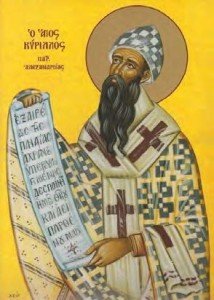St. Cyril tells us that the only human person thus far to have achieved the blessed state of union with God is the Most Holy Mother of God and Ever-Virgin Mary, through whom the Son of and Word of God became flesh. St. Cyril was the first who defended the Holy Virgin as the Mother of God against the Nestorians – those who falsely taught that Christ was merely a man in whom the divine Logos dwelt. It is no coincidence, then, that references to the resurrection of the human body abound in his writings. The theme of the resurrection of the human flesh of Christ is inextricably intertwined with our appreciation of the Holy Virgin as Mother of God.
Interestingly, St. Cyril does not refer to the Resurrection but, rather, to the Transfiguration as the clearest recorded manifestation that we have of that reward, or glory, which the righteous – those who take up their Cross and follow Christ – will receive at the General Resurrection. Cyril describes this reward in terms of participation in eternal life and glory, and vision of glory. There are, in his estimation, interchangeable terms which describe the life of the Kingdom. For Cyril, the vision of Christ transfigured is perceived as a prefiguration of the participation of the saints in the glorious life of the Kingdom, which will be inaugurated at the Parousia.
What Cyril means by Kingdom is that vision of glory, in which Christ will appear at such time when He will shine upon those on earth. Cyril suggests that Peter’s words (Luke 9:33) might have been due to his mistaking the Transfiguration for the end of the world and time of the promised participation of the righteous in the Life of God. He goes on to explain that this could not have taken place at that particular time, since the redemptive work of Christ had not been completed. Man was, therefore, still subject to the power of death and corruption and consequently incapable of enduring the revelation of Christ’s divine glory.
This brings us, Cyril believes, directly to the significance of the resurrection of the body of Christ. In his commentary on the Gospel of John, he refers explicitly to the reason for Christ’s appearance to St. Thomas and to all the apostles in His resurrected human body. I will consider Cyril’s comments on John’s Gospel in the next issue

